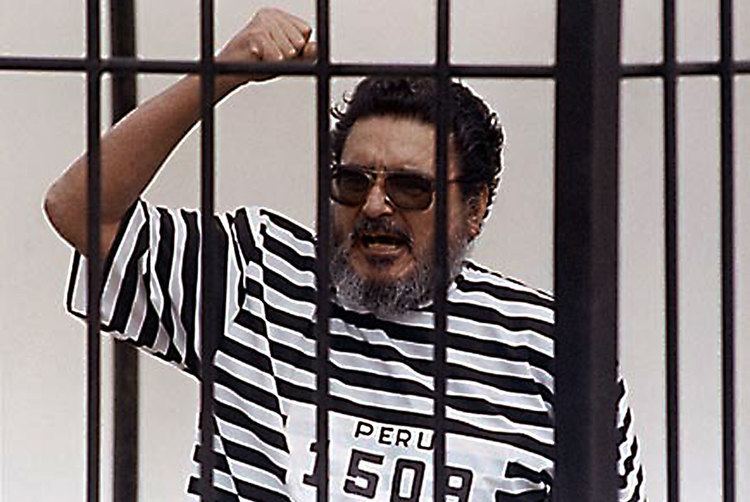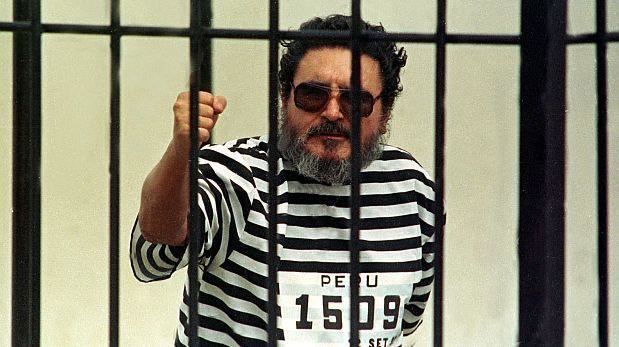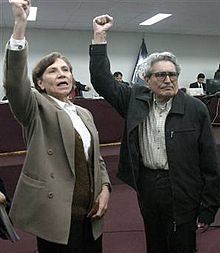Succeeded by Oscar Ramirez | Name Abimael Guzman | |
 | ||
Education National University of Saint Augustine Similar People | ||
Organizations founded Shining Path | ||
Difilm abimael guzm n la guerra seguira 1992
Manuel Rubén Abimael Guzmán Reynoso ([maˈnwel ruˈβen aβimaˈel ɡuzˈman reiˈnoso]; born 3 December 1934), also known by the nom de guerre Chairman Gonzalo (Spanish: Presidente Gonzalo), a former professor of philosophy, is the former leader of the Shining Path during the Maoist insurgency known as the internal conflict in Peru. Shining Path had been active in Peru since the late 1970s and began what it called "the armed struggle" on 17 May 1980. Wanted on charges of terrorism and treason, Guzmán was captured by the Peruvian government in 1992 and sentenced to life imprisonment.
Contents
- Difilm abimael guzm n la guerra seguira 1992
- Barrio rivadavia 1 y abimael guzm n sendero luminoso
- Early life
- The Peoples War
- Capture
- Trials and imprisonment
- References

While the activity of the insurgency increased shortly after Guzmán's capture, it has declined in the years following. It has been criticized for its violence against peasants, trade union organizers, and elected officials, which were deemed by the group to be collaborating with the Peruvian state. Shining Path is on the U.S. Department of State's "Designated Foreign Terrorist Organizations" list. The European Union, and Peru likewise describe Shining Path as a terrorist group and prohibit providing funding or other financial support.

Barrio rivadavia 1 y abimael guzm n sendero luminoso
Early life
Guzmán was born in the village of Tambo near Mollendo, a port town in the province of Islay, in the region of Arequipa, about 1,000 km (620 mi) south of Lima. He was the illegitimate son of a well-off merchant, the winner of the national lottery who had six children by three different women. Guzmán's mother, Berenice Reynoso, died when he was only five years old.
From 1939 to 1946 Guzmán lived with his mother's family. After 1947 he lived with his father and his father's wife in the city of Arequipa, where he studied at Colegio De La Salle, a private Catholic secondary school. At the age of 19 he became a student at the Social Studies department of San Agustín National University, in Arequipa. His classmates at the university later described him as shy, disciplined, obsessive, and ascetic. Increasingly attracted by Marxism, his political thinking was influenced by the book Seven Essays on the Interpretation of the Peruvian Reality of José Carlos Mariátegui, the founder of the Communist Party of Peru.

At Arequipa, Guzmán completed bachelor's degrees in philosophy and law. His dissertations were entitled The Kantian Theory of Space and The Bourgeois Democratic State. In 1962, Guzmán was recruited as a professor of philosophy by the rector of San Cristóbal of Huamanga University in Ayacucho, a city in the central Peruvian Andes. The rector was Dr. Efraín Morote Best, an anthropologist who some believe later became the true intellectual leader of the "Shining Path movement." Encouraged by Morote, Guzmán studied Quechua, the language spoken by Peru's indigenous population, and became increasingly active in left-wing political circles. He attracted several like-minded young academics committed to bringing about revolution in Peru. Guzmán was arrested twice during the 1970s because of his participation in violent riots in the city of Arequipa against the government of presidents Velasco Alvarado and Belaunde Terry. He visited the People's Republic of China for the first time in 1965. After serving as the head of personnel for San Cristóbal of Huamanga University, Guzmán left the institution in the mid-1970s and went underground.
In the 1960s, the Peruvian Communist Party splintered over ideological and personal disputes. Guzmán, who had taken a pro-Chinese rather than pro-Soviet line, emerged as the leader of the faction which came to be known as the "Shining Path" (Mariátegui wrote once: "Marxism–Leninism is the shining path of the future"). Guzmán adopted the nom de guerre Presidente Gonzalo and began advocating a peasant-led revolution on the Maoist model. His followers declared Guzmán, who cultivated anonymity, to be the "Fourth Sword of Communism" (after Marx, Lenin, and Mao). In his political declarations, Guzmán praised Mao's development of Lenin's thesis regarding the role of imperialism in propping up the bourgeois capitalist system. He claimed that imperialism ultimately "creates disruption and is unsuccessful, and it will end up in ruins in the next 50 to 100 years". Guzmán applied this criticism not only to U.S. imperialism, but also to what he termed the "social-imperialism" of the Soviet Union.
In February 1964 he married Augusta la Torre, who died under unclear circumstances in 1988. It has been rumored that she was murdered by Elena Iparraguirre, Guzmán's lover, with his complicity. Both have refused to talk about La Torre's fate since their imprisonment. In the fall of 2006, while in prison, Guzmán proposed to Iparraguirre, one of his long-time lieutenants who is also serving a life sentence in a separate prison. After fighting for the permission to marry with a hunger strike, the couple wed in late August 2010.
The People's War
The Shining Path movement was at first largely confined to academic circles in Peruvian universities. In the late 1970s, however, the movement developed into a guerrilla group centered around Ayacucho. In May 1980, the group launched its war against the government of Perú by burning the ballot boxes in Chuschi, a village near Ayacucho, in an effort to disrupt the first democratic elections in the country since 1964. Shining Path eventually grew to control vast rural territories in central and southern Peru and achieved a presence even in the outskirts of Lima, where it staged numerous attacks. The purpose of Shining Path's campaign was to demoralize and undermine the government of Perú in order to create a situation conducive to a violent coup which would put its leaders in power. The Shining Path targeted not only the army and police, but also government employees at all levels, other leftist militants such as members of the Túpac Amaru Revolutionary Movement (MRTA), workers who did not participate in the strikes organized by the group, peasants who cooperated with the government in any way (including by voting in democratic elections), and ordinary middle-class inhabitants of Perú's main cities. The Truth and Reconciliation Commission later estimated that the resulting conflict led to the deaths of some seventy thousand people, approximately half of them at the hands of the Shining Path and a third at the hands of the state.
Initially Guzmán attempted to win over the support of citizens by punishing corrupt government officials and other unpopular leaders. However, Shining Path's increasingly brutal methods together with strictly imposed curfews, the prohibition of alcohol and an overall sense of insecurity and fear led to an increased popular reaction against the communist party. Eventually Guzmán's plan backfired as rural militia or "rondas" rallied support for the military against Shining Path. The very peasants Guzmán claimed to defend had turned against the Shining Path. This resulted in a cyclical state of violence in which Maoist guerillas embarked in ruthless punitive expeditions against Peruvian civilians living in the Andean region. In 1983, 69 people (including women and children) from the highland town of Lucanamarca were tortured and murdered by the Shining Path in what became known as the Lucanamarca massacre.
Guzmán's image as a dispassionate murderer became widespread after he moved against the city of Lima. After a series of bombings and selective assassinations the whole nation was shocked in 1992 when a car bomb exploded in one of Lima's busiest commercial districts on Tarata street, thus causing many casualties and enormous material losses. To this day, Guzmán denies responsibility for the Tarata bombing by claiming that it was a "deplorable mistake."
The movement promoted the writings of Guzmán, called Gonzalo Thought, a new "theoretical understanding" that built upon Marxism, Leninism, and Maoism whereby he declared Maoism as a "third and higher stage of Marxism," having defined Maoism as "people's war." In 1989, Guzmán declared that the Shining Path (which he referred to as the "Communist Party of Peru") had progressed from waging a people's war to waging a "war of movements." He further argued that this was a step towards achieving "strategic equilibrium" in the near future, based on Maoist theories of waging people's war. Guzmán claimed that such an equilibrium would manifest itself by ungovernability under the "old order." When that moment arrived, Guzmán believed that Shining Path would be ready to move on to its "strategic offensive".
Theodore Dalrymple has written that "the worst brutality I ever saw was that committed by Sendero Luminoso (Shining Path) in Peru, in the days when it seemed possible that it might come to power. If it had, I think its massacres would have dwarfed those of the Khmer Rouge. As a doctor, I am accustomed to unpleasant sights, but nothing prepared me for what I saw in Ayacucho, where Sendero first developed under the sway of a professor of philosophy, Abimael Guzmán."
Capture
In 1992, during the first administration of President Alberto Fujimori, the National Directorate Against Terrorism (DIRCOTE) began casing several residences in Lima because agents suspected that terrorists were using them as safehouses. One of those residences, in the upper-class neighborhood of Surco, had been operating as a ballet studio. The DIRCOTE operatives routinely searched the garbage taken out from the house. The house was supposedly inhabited by only one person, the dance teacher Maritza Garrido Lecca, but it was soon noticed that the household produced more garbage than one person could account for. Furthermore, agents found discarded tubes of cream for the treatment of psoriasis, an ailment that Guzmán was known to have. On September 12, 1992, an elite unit of the DIRCOTE raided the Surco residence. On the second floor of the house, they found and arrested Guzmán and eight others, including Laura Zambrano and Elena Iparraguirre, Guzmán's female companion.
At the time of capture, the police seized Guzmán's computer, in which they found a very detailed register of his armed forces and the weapons each regiment, militia and support base had in each region of the country. Guzmán had recorded that, in 1990, the Shining Path had 23,430 members armed with approximately 235 revolvers, 500 rifles and 300 other items of military hardware such as grenades. The Shining Path remained active after Guzman's arrest.
Trials and imprisonment
Guzmán was tried by a court of hooded military judges under provisions of articles 15 and 16 of Law 25475 adopted by Fujimori's government in May 1992 after April's constitutional crisis. The reason for this was to protect the judges' lives, as Shining Path was known for brutal retaliation against judges who convicted their members. After a three-day trial, Guzmán was sentenced to life imprisonment and incarcerated at the naval base on the island of San Lorenzo off the coast of Lima.
Subsequently, he is said to have negotiated with a presidential advisor at the time, Vladimiro Montesinos, in order to receive some benefits in exchange for helping the Peruvian government put an end to the Shining Path's militant activities. Guzmán appeared several times on Peruvian television and on October 1, 1993 he publicly declared "peace" with the Peruvian government. This declaration split the Shining Path and raised questions about the organization's future. About 6,000 guerrillas within the party accepted it as a sign of defeat and surrendered. Others held that it was either a forgery or an insincere statement made under duress.
Although there is little doubt that Guzmán was indeed the leader of the Shining Path, more than 5,000 individuals presented an appeal to Peru's Constitutional Court in 2003 asking that the verdicts against more than 1800 other prisoners convicted of terrorism, including Guzmán, be voided. The court agreed, declaring that the military trials had been unconstitutional and ordering new trials before civilian courts. The new trials began in 2003. Since then, more than 400 prisoners who had been found guilty by military courts have been freed.
Guzmán's re-trial began on 5 November 2004. The international press was held in a sound-proof chamber and all media was banned from observing the trial after the Shining Path cadre turned their backs on the judges and delivered a revolutionary salute to the media gallery. The only words Guzmán spoke in the presence of the international press were "Long live the Communist Party of Peru! Glory to Marxism–Leninism–Maoism! Glory to the Peruvian people! Long live the heroes of the people’s war!" After he made this statement, the courtroom microphones were silenced and the press was unable to hear any of the proceedings that followed. When the trial resumed on 12 November, no reporters were allowed to observe the proceedings. Eventually two of the judges recused themselves and the trial ended in chaos. Guzmán's third trial began in September 2005 and was opened and closed amid a media blackout. No reporters were allowed to attend. On 13 October 2006, Guzmán was sentenced to life in prison on charges of aggravated terrorism and murder. At his sentencing, three judges read the charges in a verdict that lasted more than six hours.
In 2014, Guzmán and his wife Iparraguirre were tried again, for the 1992 Tarata bombing in Lima in which 25 people died.
Guzmán is currently incarcerated in the maximum security prison of the naval base of Callao, the port of Lima. His neighbours include Víctor Polay, leader of the Túpac Amaru Revolutionary Movement, and, ironically, Vladimiro Montesinos, the former head of the National Intelligence Service who supervised the construction of the prison and served under the (now also imprisoned) President Alberto Fujimori.
